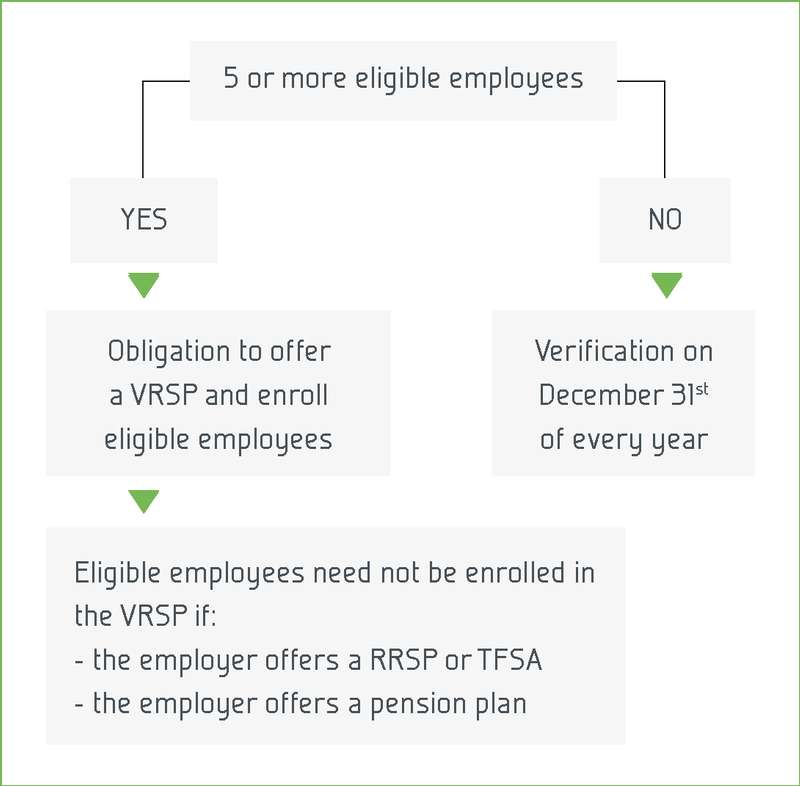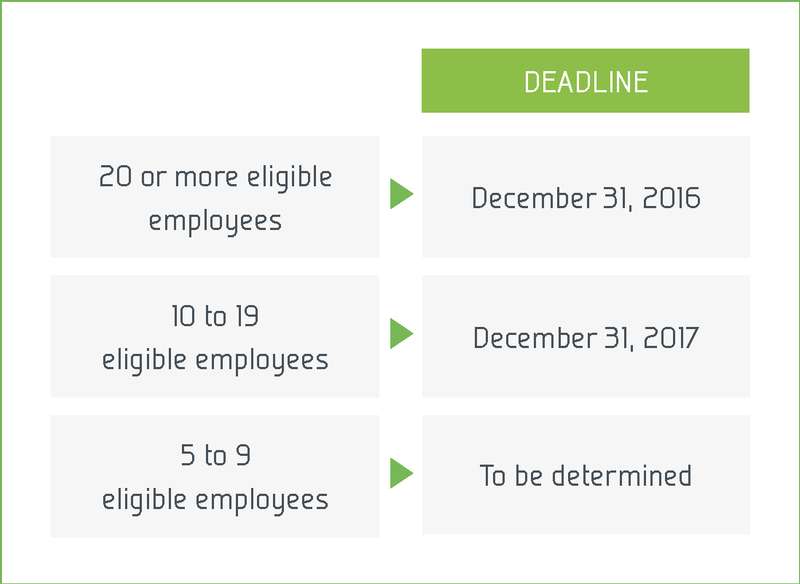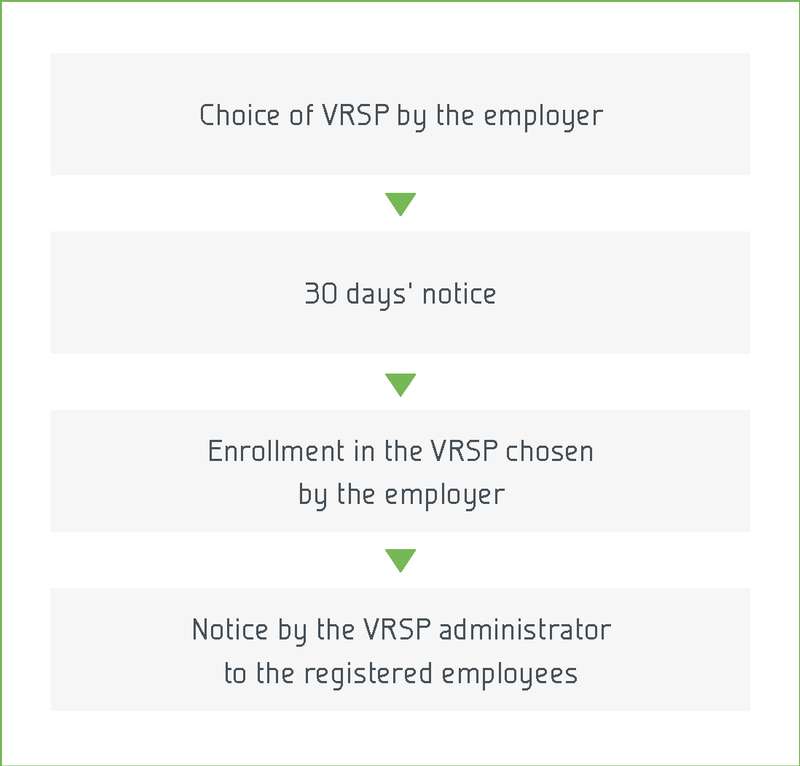On July 1, 2014, most of the provisions of the Voluntary Retirement Savings Plans Act1 (the “VRSP Act”) came into effect. At the time, this raised questions in the minds of numerous employers about their obligations under this new law. Since a first group of employers had until December 31, 2016 to comply with certain obligations, we are providing you with a summary of the main obligations of employers under the VRSP Act.
But before anything else: what is a VRSP?
It is a group retirement savings plan set up and administered by an authorized administrator and governed by the VRSP Act. VRSPs are designed to have a low cost in order to encourage saving for retirement.
|
|
Which employers are covered by the VRSP Act?Any employer that has an establishment in Québec and five or more “eligible employees”. What is an “eligible employee”?According to the VRSP Act, it is essentially an employee2 who:
If an employer does not have five or more eligible employees, it must ensure, on December 31st of every year, that it still does not have five or more eligible employees. If an employer has five or more eligible employees, it has the obligation to offer a VRSP and to automatically enroll all of its eligible employees therein. But! The employer is not required to enroll any eligible employee in the VRSP if the employee:
|
|
|
When must the VRSP be offered?The deadline by which an employer must offer a VRSP and automatically enroll its eligible employees depends on the number of eligible employees on certain given dates. The deadline for employers with 20 or more eligible employees as of June 30, 2016 was December 31, 2016. The deadline for employers with 10 or more eligible employees as of June 30, 2017 is December 31, 2017. Note that the deadline has yet to be determined for employers with 5 to 9 eligible employees, but it will not be before January 1, 2018. |
|
|
Choose a VRSP set up by an authorized administrator and give notice to the employeesAn employer who is required to offer a VRSP must choose from among those set up by the authorized administrators. A list of authorized administrators who have set up a VRSP is available on the website of Retraite Québec.6 Once it has made its choice, the employer must, no less than 30 days before offering the chosen VRSP, notify its eligible employees7 in writing that:
This written notice must also contain all the other information required by the VRSP Act. Once the employer has joined the chosen VRSP, it has 30 days to enroll its employees with the VRSP. The VRSP administrator will then send a written notice to the enrolled employees, by the statutory deadline, containing the prescribed information. |
Is the employer required to contribute to the VRSP?
Under the VRSP Act, the employer has no obligation to contribute to the VRSP on behalf of its enrolled employees. If it chooses to contribute, it may subsequently change its contribution, subject to any contrary clause contained in a collective agreement or individual employment contract. To change its contribution, the employer must give written notice to the employees concerned and to the VRSP administrator. If the amendment has the effect of reducing its contribution, it cannot take effect before the 30th day following the date written notice is given.
Other obligations of the employer
Employers who must offer a VRSP also have other obligations under the VRSP Act. The following is a non-exhaustive list of those obligations.8
Opting out of or not contributing to the VRSP
Employees may opt out of the VRSP offered by their employer by advising in writing of their intention to do so within the time period specified in the VRSP Act. In such a case, the employer must retain this written notice for the entire duration of the employee’s employment. The employer will also be required to verify periodically whether the employee wishes to change his/her mind and enroll in the VRSP. This must be carried out in the month of December, every two years following the employee’s decision to opt out.
If an employee has decided to opt out of the VRSP, the employer must also give the VRSP administrator written notice within 30 days of its receipt of the written notice from the employee.
Pursuant to the regulation, enrolled employees may set their contribution rate to 0%.9 When an employee does so, the employer must periodically give them the opportunity to start making contributions again. The employer must do so in the month of December, every two years following the date on which the contribution rate was set to 0%.
Deduction and payment of contributions
The employer must deduct the contributions of each employee who is a member of the VRSP from his/her pay cheque10 and pay it to the VRSP within the time period specified in the statute, i.e. no later than the last day of the month following the deduction thereof (for example, contributions collected in April 2017 must be paid into the VRSP by May 31, 2017).11 Should the employer not pay the contributions to the VRSP within the requisite time period, the employer will be required to pay interest at the rate and according to the method specified in the regulation.12
Access to documents
The employer must make the following documents available to employees at their request and free of charge: the contract between the employer and the VRSP administrator and the VRSP’s annual statement and financial report.
Submission of documents or information to the VRSP administrator
The employer is required to provide the VRSP administrator with any documents or information it requests and which are necessary to comply with the VRSP Act.
Termination of employment
Where an employee’s employment is terminated, the employer must notify the VRSP administrator thereof within 30 days.
Contravention of the VRSP Act
Different bodies are responsible for applying the VRSP Act, including Retraite Québec and the Commission des normes, de l’équité, de la santé et de la sécurité du travail (the “CNESST”). Moreover, the CNESST oversees the employer’s compliance with its obligation to offer a VRSP to its eligible employees.
In the event of a violation of the VRSP Act, the employer may be subject to penal sanctions, among other things. Indeed, the VRSP Act states that if an employer fails to pay a contribution to the VRSP by the specified deadline or to offer a VRSP within the time period prescribed by law, it commits an offence and may be liable to a fine ranging from $500 to $10,000. Fines are doubled in the event of a subsequent conviction.
Where the employer violates any of its other obligations under the VRSP Act, it commits an offence and may be liable to a fine of $600 to $1,200, which, again, is doubled in the event of a subsequent conviction.
In closing, we note that, as reported by some recently published articles, it appears the CNESST will only intervene if a complaint is received. If you were supposed to offer a VRSP by no later than December 31, 2016 and you have not yet done so, you should act quickly. However, if a complaint has been filed with the CNESST, you could be subject to prosecution and payment of a fine.
- R.S.Q., c. R-17.0.1.
- According to the definition contained in the Act respecting labour standards, R.S.Q., c. N-1.1.
- As defined in the Act respecting labour standards, R.S.Q., c. N-1.1.
- Within the meaning of this expression in the Income Tax Act, R.S.C. (1985) c. 1 (5th Supp.).
- Where an employer offers membership to all its eligible employees in a pension plan, or in an RRSP or TFSA (through source deductions on their salary), and some of them decide not to enroll, the employer is not obligated to offer a VRSP to the employees who have chosen not to enroll.
- Retraite Québec website (in french only).
- The employer is not required to give notice to the eligible employees who are excluded from the enrolling requirement, as previously noted.
- We note that the VRSP Act expressly states that the employer is not liable for any acts or omissions of the VRSP administrator.
- Regulation respecting voluntary retirement savings plans, R.S.Q., c. R-17.0.1, r. 3.
- It must begin collecting the contributions as of the first payroll following the 61st day after the requisite notice is given by the VRSP administrator to the enrolled employees once the employer has joined the VRSP. The VRSP administrator must inform the employer without delay of the date on which such notice was given.
- If the employer has chosen to contribute, it must pay its own contributions within the same time period as that specified for the payment of the employees’ contributions.
- We note also that until they are paid to the VRSP, the contributions and accrued interest, if any, are deemed to be held in trust by the employer, whether or not it has kept them separate from its own assets.



